|
Rev. William Cowper D.D.
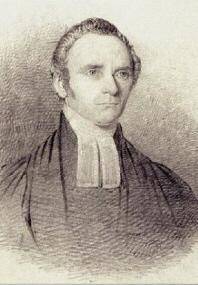
Early Life
Samuel Cowper (b. 1745, d. aft 1800) a Yeoman farmer from Sedbergh in Yorkshire England, married Isabella Sedgwick of Dent, Yorkshire, at St Andrew's Parish Church, Sedbergh on Wednesday 25 May 1768
The family had four known children;
- Leonard Cowper (1769 – Unknown)
- John Cowper (1774 – 1857)
- William Cowper (1778 – 1858)
- Thomas Cowper (1781 – 1781)
William the third son of Samuel and Isabella Cowper, née Sedgwick, was born 28 December 1778 at Whittington, Lancashire England. He was baptised in the Church of St. Michael The Archangel, Whittington on the 20 June 1779. William and his older brother John spent the early years of their lives living at Sellet Manor in Kirkby Lonsdale, the Manor is now known as Sellet Hall.
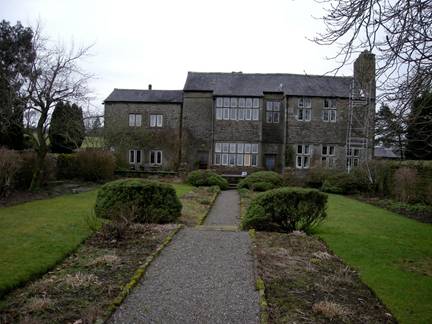
Photo - by Peter Bolt
Education
William Cowper was educated at Sedbergh School during a difficult period for the school. The Headmaster Wynne Bateman, who was at the school from 1746-1782 was not a particularly forward thinking Head, and the school fell into disrepair during his time and lost most of its students. Because of this few people wanted to take over the Headmastership after his departure in 1782. His successor Christopher Hull, who was head from 1782 – 1799 (during William Cowper’s time) was selected more because he was willing to do the job than for any particular skills! He was a 41 when he became Headmaster and had no teaching experience. His Latin and Greek (at that time essential parts of an English Boys education) were too poor for him to teach but despite requests from the governors he would not employ an assistant master educate the boys in areas where his knowledge was lacking. One of his students ‘Canon Shepherd’ recorded in his private papers as an adult that in good weather Hull was more interested in taking the boys walking and shooting on the fell than educating them. William will have learned his mathematics from John Dawson, the leading mathematical genius of the day, which supports William's great skill with mathematics which was said to be a hobby along with astronomy.
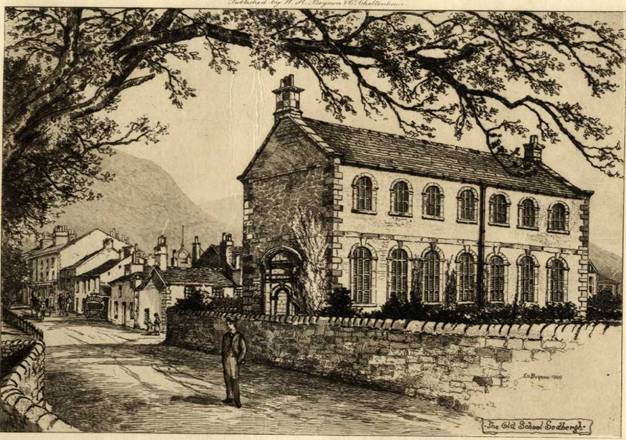
Photo Supplied by Sedbergh School, with notes from Katy Iliffe of Sedbergh School
Married Life and Family
William married Hannah Horner, daughter of Henry Horner and Mary Cambage, in the Church of St. Mary, Richmond, North Yorkshire, on 11 April 1799. At that time, he was a Private in the 2nd North Yorkshire Militia, and was stationed at Northallerton, North Yorkshire. Soon after marrying Hannah, he was transferred to Scarborough, North Yorkshire, where he was disembodied (discharged) on 5 December 1799. The couple moved to a small village called Drypool, near Hull in Humberside, England, and it was shortly after arriving there, that their first child Henry was born in 1800, followed by Thomas in 1802 then Mary Stephena in 1805 and finally Charles in 1807.
God Calls
After leaving the North Yorkshire Militia, William became interested in Religion, and sought guidance and training in the Parish of St. John the Evangelist, Hull under the direction of its Founder the Rev. Thomas Dikes. William went on to be ordained Deacon on 20 March 1808, in Winchester Cathedral, by the Bishop of Winchester, Brownlow North. He was ordained a Priest on 10 April 1808, in the Church of St. Andrew, Holborn, England, by the Bishop of Bristol, John Luxmoore. Following his Ordinations, William and his family returned to Drypool, where sadly and tragically for the young family William's wife Hannah died on the morning of 8 June 1808, at age 25. Her death notice in the Hull Packet Newspaper of 14 June 1808, states she died "after a very short illness". Hannah is buried in the St. Peter's Church Cemetery, Drypool. (Which no longer exists today)

Source: The Hull Packet and Original Weekly Commercial, Literary and General Advertiser (Hull, England), Tuesday, June 14, 1808; Issue 1118
There are several references stating William was Licensed as a Curate in the Parish of Rawdon³, near Leeds, England. However, according to the Church of England Archives at the Borthwick Institute of Historical Research, in York, and at Lambeth Palace, there are no surviving records of William holding any appointment in England to support this contention. Yet there is overwhelming evidence to support his presence in the Parish of St Peter, Drypool, both before and after his Ordination, with reports in the Hull newspaper of William ministering in the area. Further to this it was in Drypool that the Reverend Samuel Marsden, First Colonial Chaplain to NSW, first met William, Rev. Marsden, in search of two additional chaplains, invited him to accept appointment to serve in New South Wales. He was willing, and received a commission as an assistant chaplain in New South Wales at a salary of £260.
After leaving Drypool on his way to Sydney, William stayed in Newington, Surrey, for a short while where he met and married his second wife Ann Barrell, from Drinkstone Suffolk, in the Church of St Augustine, London, on 21 January 1809. Witnesses at Ann and William's Wedding were John Barrell, Margaret Amey, Joseph Hunter & Thomas Peppercorn¹. (Information supplied by the Guildhall Library, Aldermanbury, London.)
The Voyage
William and his new wife Ann, and the four young children from his first marriage, set sail aboard the French built Brig. "Indispensable", a convict transport vessel with 62 female convicts aboard, to take up the position of Colonial Chaplain in the new Colony.
The ship left Portsmouth on 2 March 1809, the voyage taking 169 days via Rio de Janeiro and Cape of Good Hope before arriving in the 'New World' of Sydney Cove on the 18th August 1809, a place far removed from family and the green fields of England.
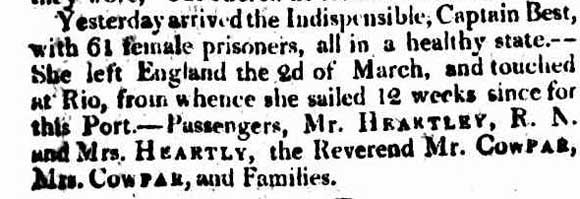
Published: The Sydney Gazette. Sunday 20 August 1809
Early Life in Sydney
On arriving in Sydney William took up residence at St. Philips Parsonage, Sydney, and so early in their life in the Colony Ann gave birth to William’s fifth child, a son, William Macquarie Cowper, on 3 July 1810, his first and only child by Ann.
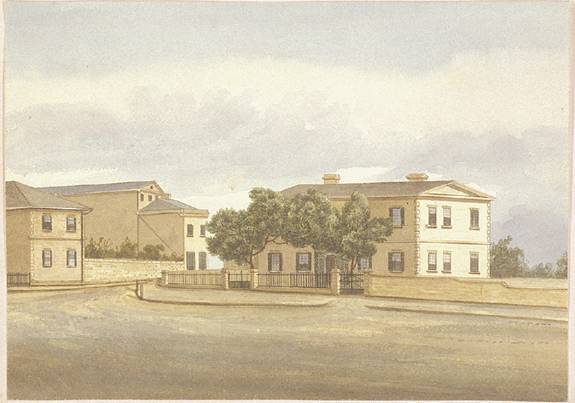
St. Philip's Parsonage, Macquarie Place, Sydney
Ann took particular interest in the welfare of the Colonies children and was appointed along with Mrs Marsden as Vice Patronesses to the Female Orphan Institution on the 6 May 1820 - and taught the children with her step-daughter Mary Stephena Cowper - William held Ann with the greatest of admiration and was deeply saddened when she died that he commissioned a memorial to her in St Philip’s Church – for which William had the marble imported from England.
Sadly Ann died in Sydney on 25 January 1831, aged 49.

|

Source: Sydney Gazette, 27 January 1831 |
William remarried for the third time, in St Philip's Sydney on the 01 March 1836. His third wife was Harriette Swaine, daughter of John Swaine and Elizabeth Ann Arden of Leverington, Wisbech, England. William and Harriette had 3 children, Elizabeth Ann, b. 1836, Sedgwick Spelman b.1839 & Isabella b.1840.
Harriette's brother Spelman Robertson Swaine (1811– 1843) , was a Doctor practicing in the Campbelltown / Camden area.
St. Philips Church 4
In January 1788 eleven ships and their companies, under the command of Captain Arthur Phillip RN, and carrying 759 people arrived at Botany Bay, New South Wales to establish a penal colony. The Chaplain of this ‘The First Fleet’ was the Rev Richard Johnson and he conducted the first Christian service in Australia on 3 February 1788.
The wattle and daub church built by Richard Johnson in 1793 was burnt down in 1798. A new stone church named St Philip’s was opened in 1810, and this was replaced by the current building in 1856. Captain Phillip’s second in command, and the third Governor of New South Wales, Philip Gidley King had proclaimed the Parish in 1802.
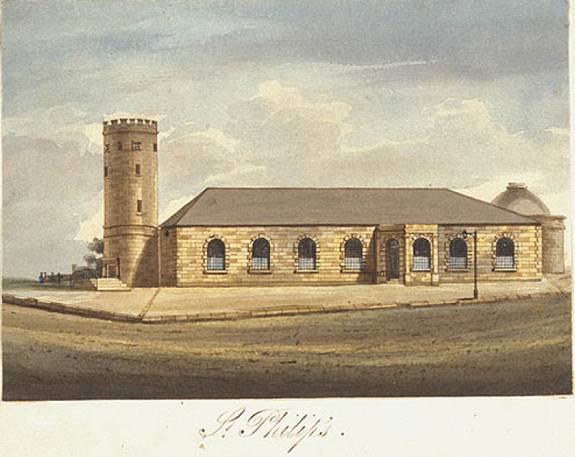
St. Philips in Richard Jones’ Album.
We are fortunate enough to also have sketches of the original church and its floor plan which were amongst the many documents in the ‘Keith Cowper’ collection which was handled down to Elizabeth Eugenie Field from her grandmother Elizabeth Ann Cowper, Williams’s daughter.


William's Ministry
Prior to his departure from England William had already been appointed as Assistant Chaplain to the Parish of St. Philip, Sydney, effect from the 1 January 1808 (which was interestingly three months before his Ordination) and then on the 15 September 1810, he was appointed Resident Chaplain. He supposedly preached his first sermon in St. Philip's on 20th August 1809, within 48 hours of his arrival.
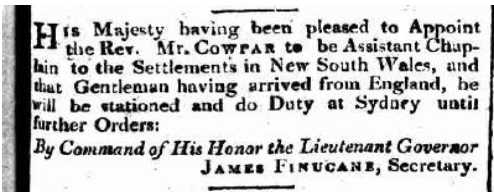
Source: Sydney Gazette, August 1809
The burden of Cowper's clerical and official duties took their toll. In 1812 he had suffered from some form of rheumatic fever, probably contracted in the gaols, and his slow recovery marked the beginning of a life of constant ill health. Reports of this ill health were made in 1818 and 1829 by William Grant Broughton, Marsden and Darling, but it was not until February 1842 that the formation of cataracts on both eyes compelled him to take leave and return to England for treatment.
The esteem with which William was held by his parishioners was made evident when the sum of nearly £600² was raised towards the cost of the trip and treatment. William returned to England in 1842-43 for treatment to his eyes, and whilst there, on 25 January 1843 the Archbishop Howley of Canterbury conferred upon him the Honorary Degree of Lambeth Doctorate of Divinity (D.D.) for his long and faithful service to the Church in Australia. On 24 January 1848, he was appointed to the newly created Archdeaconry of Cumberland and Camden, and on 1 May 1848, he laid the "Foundation Stone" of the second and present Church of St. Philip, Sydney. He had the satisfaction of preaching the first service in the completed building on 30 March 1856. In 1852, he acted as the Commissary of the Bishop of Australia during the Bishop's absence in England.
Rev William Cowper was Rector of St. Philip's for 49 years. His son - William Macquarie Cowper - the first clergyman to be born in the colony followed him as Rector for 11 years.
In the chancel of the current church there is a tablet to the memory of the Venerable William Cowper, who in his 49 years as the Rector of both the first and second St. Philip's is remembered as one, "who gave himself wholly to the work of the ministry".
Williams Death
William died in Sydney on 6 July 1858, at St. Philip's Parsonage, Macquarie Place, and was accorded a Public Funeral by the Government, at which there were present the Governor-General, the Chief Justice, the Judges, Members of the Executive Council, President of the Legislative Council, the Speaker of the Assembly, Members of both Houses of Parliament, Civil Officers of the Government, Officials of the University, children from the schools within the Parish of St. Philip, and no less than thirty six Ministers of the Church of England plus Clergy of all denominations. The Archbishop, Bishop and Officials of the Diocese also attended along with a huge crowd of mourners which lined the entire route from St. Philip's to the Devonshire Street Burial Ground at the southern end of the City. The funeral was extensively reported by the Sydney Morning Herald on 9 July 1858. Then in 1901, following a Government decision to resume the Devonshire Street Cemetery to make way for the building of Sydney's Central Railway Station, and the underground rail system, the body of Rev. William Cowper was relocated to the St. Jude, Church Cemetery, Randwick, NSW where he remains today in eternal peace.
It is not clear what happened to the remains of his second wife Ann and his daughter Isabella who were also buried at the Devonshire Street Cemetery. It appears they may have been relocated to Botany Cemetery. William's widow Harriette died in Derby, England on 6 January 1869.
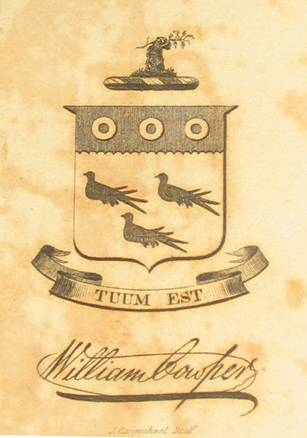 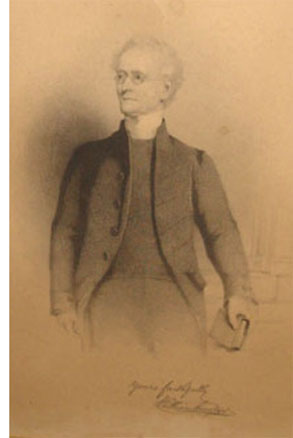
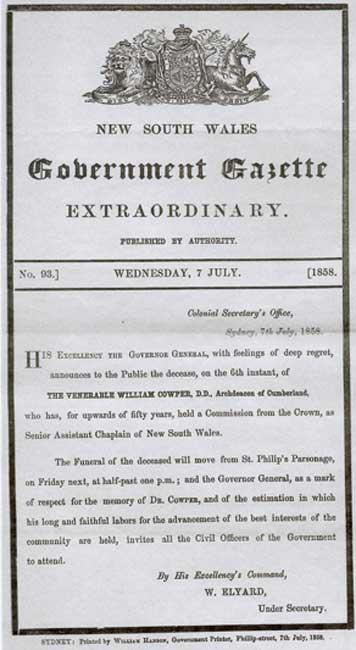
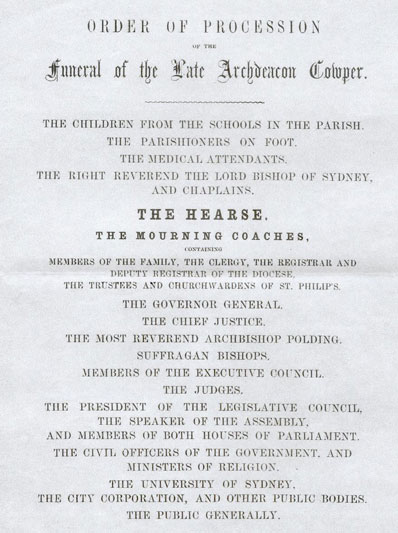
Funeral of the Late Archdeacon Cowper

William Cowper Grave, St Jude's Cemetery, Randwick NSW
Buried with William is his son William Macquarie Cowper (d. 1902) and his wife Mary Cowper (d. 1894)
William Cowper Obituary - click here to view (PDF)
William Cowper Will - click here to view (PDF)
Notes and Acknowledgements:
- Interestingly Thomas Peppercorn is also mentioned in family papers about Harriette Swaine who later becomes Williams 3rd wife. It would seem that Ann Barrell and Harriette Swaine may have known each other before they became the successive wives of William Cowper.
- The Sydney Gazette Tuesday 12 October 1841
- Peter Bolt explores the details of William Cowper’s Rawdon curacy in greater detail in the soon to be published book.
- Source: http://www.stphilips-sydney.org.au/
Other Links for William Cowper
http://www.adb.online.anu.edu.au/biogs/A010243b.htm
http://www.stphilips-sydney.org.au/resources/history/
http://en.wikipedia.org/wiki/William_Cowper_(clergy) |
|

